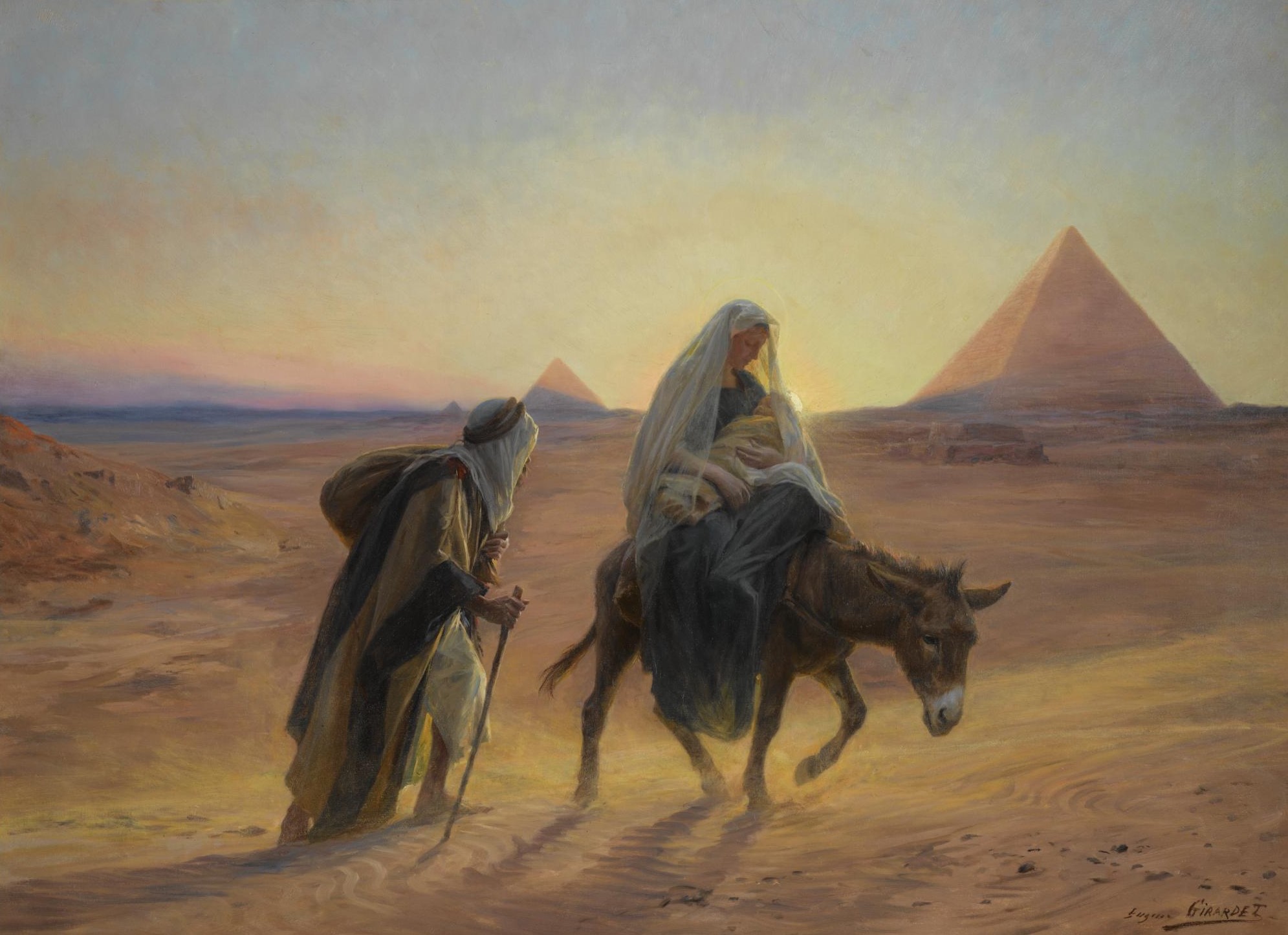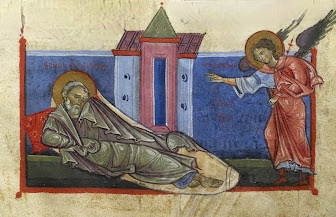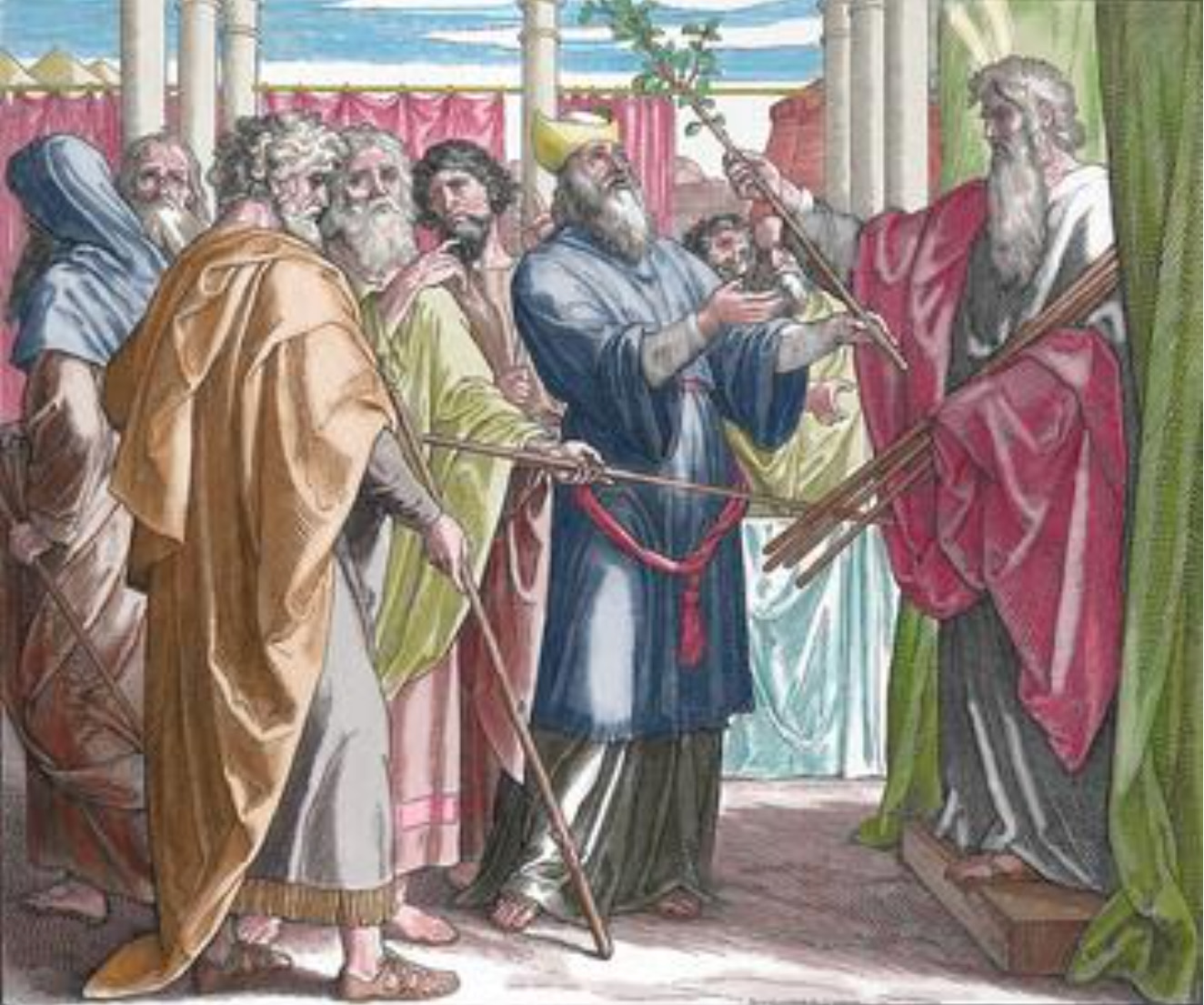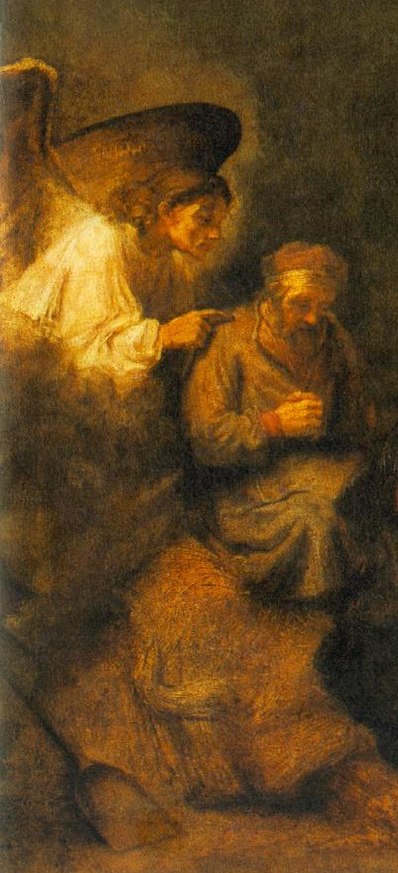
As we continue our Nativity stories, we find Joseph receiving his latest instructions from an angel of God: "Take the Child and his mother to Egypt."


As we continue our Nativity stories,
we find Joseph receiving his latest instructions from an angel of God:
"Take the Child and his mother to Egypt."
Picture them crossing desert wastes, which is what you find as you head south and west out of Jerusalem, passing down toward Jericho, and then entering into the rocky, sterile terrain around the Dead Sea. The caves of Qumran are not far from here. Ahead is the forbidding wilderness of the Sinai Peninsula. Today the trip from Jerusalem to Cairo in a car traveling 40 MPH would take 44+ hours. Of course, the car might need to rest every seven or eight hours with temperatures soaring up to 114° F. and dropping below freezing at night. What a curious sight they would have made: the elderly Joseph; the athletic, young James, his son; the teenage mother, Mary; and the tiny infant. In them could be seen the entire span of a human lifetime from new birth unto aged decline and death, unto eternity in the Person of God's Son.
What is being asked of Joseph is epic-scale. Our unlikely hero is a hoary-headed Odysseus, traveling through far-flung and dangerous lands, setting his stooped and aged frame between the little dove, Mary, her helpless, fragile Son as a bulwark against every peril they might encounter. Did I say peril? These people are being hunted down by men with blood in their eyes by order of a king "that they might they might destroy them," we read this morning in our Gospel lesson.
How slight are the burdens we bear by comparison. Like Joseph, we too have been called by God. He has called us into religious life with its vows of chastity, poverty, and obedience here at the Hermitage .... well, long before that.
In our overheated culture, chastity is always singled out first, rejected out of hand as a kind of deformity of normal life. Yet this particular vow is one to which God calls every one of us: guarding one's chastity until marriage, practiced in the course of normal life for thousands of years — this guardianship, this custodianship, this protectorate of our chastity practiced for thousands of years.
Of course, the ordinary state of Christian life is married life. We may call it an ideal. Second after that is single life perhaps leading to marriage. Religious life? Well, that is something else altogether, a holy state of life, to be sure.
As a side note, I share the irony that most adults in the U.S. practice celibacy, a word which means simply "not married." Fewer than half of all adults in the U.S. are married, the lowest figure in this country's history, according to the Pew Research Center. Of young people age 19-24, those years once accounted to the "marrying years," only 9% choose to marry. By contrast, in 1960 (the year before Sr. Mary Ann presented herself at the Convent) roughly half of those in the marrying years married.
All of this points back to Joseph, Mary, and James: the chaste widower, the virgin mother, and the devout young, single man. Today, on his feast day, we see all this fanned out around Joseph' — married life with children and the religious life into which he has been called. We call Joseph the "Betrothed." In the Western Church he is styled, "most chaste spouse." You see, we are we are entering into the deeper mysteries concerning that relationship we call marriage.
If you open the catalogue of St. Ignatius Press Books and Films, you will see Joseph is depicted as a young man, about to marry for the first time. He is paired to the young teenage fiancée, Mary. He is vigorous and full of energy. He and his wife are about to settle in Nazareth, where they will start a family. He is overbrimming with the sweet sap of youth: building a house, shaping new furniture in his workshop, anticipating the arrival of his blushing bride. He'll sweep her into the new house, in his arms .... according to St. Ignatius Press.
But all of this is invented .... and very long ago. There are no traditions in the Church that depict such a Joseph. None of the Fathers attest a teenage couple. They attest a devout and elderly man. He is widowed. He is surrounded by grown children. The sweet sap of energy and youth are a distant memory. At his point in life, he feels only the weight of age upon a wearied frame.

The true story was well known
to the Early Church,
as well known as the Gospels.
With other elderly men of devout character,
Joseph has been summoned to the Temple by the High Priest.
A most holy, consecrated virgin
has lived in the Temple there since age two.
Her life has been an offering to God
mediated through her parents Joachim and Anna
and
the High Priest,
who confirms their account of God's action in their lives.
But now the Temple faces a problem.
According to the
laws governing ritual purity,
Mary cannot
remain
within the precincts of the Temple.
A guardian must be identified from among the assembled group of mature and devout men.
You see, the things that happen to a twelve-year-old girl are now happening to her.
Each elderly man is given a rod. Then, in the sight of all, a dove emerges from Joseph's rod and alights on his head. He is to be God's chosen agent. At first, Joseph resists. He anticipated a life of fewer responsibilities, not more. He winces as he imagined the jibes he will hear from his grown sons, bringing a bride home to Nazareth .... yes, for the purposes of guardianship, but nonetheless ....
The seventh-century Gospel of Pseudo-Matthew attests the story of the pure, white dove emerging from Joseph's rod, but later legends have pushed back against the miraculous. (What?! A dove somehow flying out of a wooden rod?!) So later centuries invented a white lily sprouting out the end of Joseph's rod. To them this seems a little less miraculous. But aren't miracles an on-off kind of thing? They are miracles, or they aren't .... however they come.
Today, we have pushed back back even more firmly. We must have a young Joseph. We do not want the old man .... not even at Roman Catholic St. Ignatius's Press. So everywhere we now see the young couple. Here they are: Mr. and Mrs. Joseph! How old are they anyway? I suppose she is thirteen, and he is fifteen or sixteen.
The text for the actual account, the Protoevangelion of St. James was treated as Scripture by the Early Church. Scholars identify it as being "second-century." But we must remember that scholarly guess work always renders a later date. In truth, we cannot be sure when these pages were written down. We ought to say "at least as early as the second century." Then there is this other problem: the composition date we are given refers to the book's production, whether scrolls or codices or vellum or paper (papyrus). It does not pretend to be a date for the story contained within the book. Precedents such as the Holy Gospels teach us that narratives were transmitted for decades before they were written down. We do not know in fact whether the Protoevangelion of St. James enjoys the same early date as the Gospel of St. Matthew, whom the majority now date to 92-110 A.D. You see, it was transmitted for decades orally until someone in the community where it was primary wrote it down. The more imposing precedent are the Hebrew Scriptures themselves, which were orally transmitted for thousands of years. It was only the cataclysm of 70 A.D., with the destruction of Jerusalem, that book production went into high gear in a desperate attempt to preserve a religious lifeworld.
Why didn't they write these things down? It is not as if they lacked for intention, zeal, or paper. The answer is a sacred answer: because the spiritus, which God breathed into us, and we breathe back out again is holy. Scrolls and codices were not holy. Yes, we call certain books today holy because they have become our repositories of the Divine.
To invent a teenage Joseph, you must reject the Church Fathers as well as all Scripture not contained in the biblical canon. And when did the Canon of Scripture occur? Three centuries later!
The case for the young Joseph, who can't wait for his honeymoon, you know, rests upon a solitary word, ἕως / heos . translated as until:
|
.... και
ούκ
εγινοσκεν
αυτην ἕως
οὑ
ἔτεκεν
υἱον:
και
εκαλεσεν
το
ονομα
αὐτου
Ιησουν.
.... kai ouk eginosken autyn heos hou heteken huion kai ekalesev to ovoma autou Iesouv. .... and did not know her till she had brought forth her firstborn Son. (Mt 1:25) |
Let us render the invented Mary and Joseph in idiomatic American English:
| Joseph and Mary did not have regular intercourse until after her first son was born. |
The Hermitage uses the NKJV version of the Bible following guidelines set by our Church (because its Old Testament is found upon the Septuagint). But we do not forget that the base translation, the King James Version, is a Protestant translation, completed nearly a century after Henry VIII broke with the Roman Church.
In the passage before us, the Greek is twisted to achieve a certain theological objective, which is to deny and dismiss the perpetual virginity of the Most Holy Theotokos. The translators are grinding an axe as Ever-Virgin Mary awaits her execution. Don't forget that these are same people who burned any Catholics they hunted down at the stake.
In no Greek manuscript containing Mt 1:25 do we find the word "firstborn." The Greek says only huion or "Son." "Firstborn" has been inserted by a translator to imply that Mary would bear other sons following the birth of Jesus. Why else would you say "first born son" if He were not One among many? of all the others? No doubt, the translators had in mind James, Joseph, Judas, and Simon, whom the Orthodox Church understands to be the sons of the elderly Joseph by his now-deceased wife.
The King James translators then follow this with a "not .... until" construction: "He does not know her until ...." implying that Joseph and Mary would have regular conjugal relations as soon as this business of Jesus' birth is behind them. But the underlying Greek pulls us into first-century Greek idiom for describing events in time.
Anyone who knows ancient languages will tell you, events in time is always a tricky thing. We need look no further back than Shakespeare to find that "before" means "after," and this is only Early Modern English.
So let us consider an analogue from the same Gospel. Jesus says,
| "Behold, I am with you until the end of the age." |
Here again the underlying Greek word for until is ἕως / heos. Is Jesus saying that He will no longer be with us after Heaven and earth pass away? Is not the whole point of Heaven and earth passing away is that they will no longer impede our union with Him, with God? No, of course not. We should view heos in this context as an intensive form, like the word even ("Even so!"). It draws attention to a great event, which is "the end of the age." ("Until the end of the age! Even then!") Jesus, of course, will be with us before then, and He will be with us after then. The construction intensifies our sense of the greatness of all of this just as the construction at Mt 1:25 intensifies emotional intensity: Joseph will reverence the most holy virginity of Mary before Jesus is born and after Jesus is born. Heos / until.
Lastly, the King James translators ignore outright the plain meaning of Greek grammar, which gives away their tendentious purposes. The Greek word ούκ does not equate to the English not: (for example, ".... and did not know her (sexually) until the birth of her son.") The word ούκ is defined as a negative construction anticipating an affirmative reply. It is a rhetorical trope. For example, we picture the orator with his finger raised heavenward or the trial attorney before the jury. "Is it not the case that ....?!" That is what this not means.
The correct translation, therefore, should something like this:
| ..... and should not Joseph be expected to receive his due (which is conjugal relations with his wife) if it were not for several extraordinary facts: that he is elderly, that he is the guardian of a teenager, that this teenager is a consecrated virgin of the Temple, and that this consecrated virgin is not just any virgin, but the most holy Mary. |
Here is the plain meaning of this passage in Greek.
The overall purpose of Matthew 1:25 is to call to mind the heroic sacrifices being offered by the young girl, Mary, and by her elderly guardian, Joseph. You say, they make an odd couple? No insofar as they are heroic. And they love each other as the saint always love the faithful ones around them .... as few other loves can ever be expressed on this earth. Both have consecrated their lives to the purposes of God's plan. They do not know what the plan is. It is enough to know that it is God's.
And we who are reading all of this realize that these plans include nothing less than the salvation of mankind. This unlikely couple, these two, are not just any heroes. From our selfish point of view, they are, along with the infant Jesus, the greatest pantheon we could possibly devise. The greatest heroes of history. And (casting our eyes on Hell) there but the grace of God, in their faithful hands, go we.
From the time they have appeared,
readers have marveled at the concision of the Holy Gospels.
How do we know they are holy?
Just read them:
the disjunction between their terseness,
on the one hand,
and
their transcendent content, on the other,
is apt to make the hairs on our necks stand on end
.... not to mention their breathtaking beauty.
Very few words are offered to describe Joseph or Mary.
Therefore,
I wonder how often we notice that Joseph only encounters
the angel of God while dreaming:

|
But while he thought about these things, behold, an angel
of the Lord appeared to him in a dream, saying, "Joseph,
son of David, do not be afraid to take to you Mary your
wife ...."
(Mt 1:20)
Then Joseph, being aroused from sleep, did as the angel of the Lord commanded him and took to him his wife .... (Mt 1:24) Now when they had departed, behold, an angel of the Lord appeared to Joseph in a dream, saying, "Arise, take the young Child and His mother, flee to Egypt ...." (Mt 2:13) Now when Herod was dead, behold, an angel of the Lord appeared in a dream to Joseph in Egypt .... (Mt 2:19) |
Are we to believe that sleep is the necessary ingredient for encountering an angel? Mary is not sleeping when she encounters Gabriel. We believe she is spinning or weaving in private quarters within the Zion Temple. Zechariah is not sleeping when he encounters Gabriel. He is standing at the Altar of Incense within the Zion Temple. The wealthy farmer is not sleeping when he encounters an angel of the Lord. We picture him in his counting house planning his new barns. But Joseph is always sleeping when he encounters an angel of the Lord. Perhaps we are so fixed on the angel that we miss the obvious point about Joseph: he is always drifting off to sleep. He is old.
By the way, this last passage, Mt 2:19, is the final time we will hear of Righteous Joseph the Betrothed in St. Matthew's Gospel. In this last scene, he has been napping, and the angel of the Lord rouses him with new instructions. Yes, he may now bring Mary, Jesus, and James back to Jerusalem. But before he arrives there another dream seems to have come to him during a nap and steers the family up to the hill country of Galilee. After this, our beloved hero simply fades from the story. In St. Matthew's account, we imagine them arriving to to Nazareth, but then we see him not again. That is, he does what all elderly men soon do: he dies.
In all of this we see the lineaments of a great hero. His feats have been heroic. He is the one who, being called by God, strove to the final breath. He has completed the Labors of Hercules, but this man of deeds completes his course in extreme old age. When we first meet him in the Zion Temple, he tells the High Priest, "I am too old." Yet, he pick up his cross and bears it. He bears it over many miles. Yes, he had dreamed of rest and fewer demands. Nonetheless, he has been faithful to the last. He carries that cross until, like the Son Who has been entrusted to Him, he stumbles under the weight of it and stumbles again. And he makes his way to an obscure hill, where no one will witness his final and most humble oblation. No one will thank him. No one will congratulate him as he lays his strained and sprained and broken body down at the gates of Heaven.
And all the saints of God will say, "Perfect!"
In the Name of the Father and the Son and the Holy Spirit.
Amen.